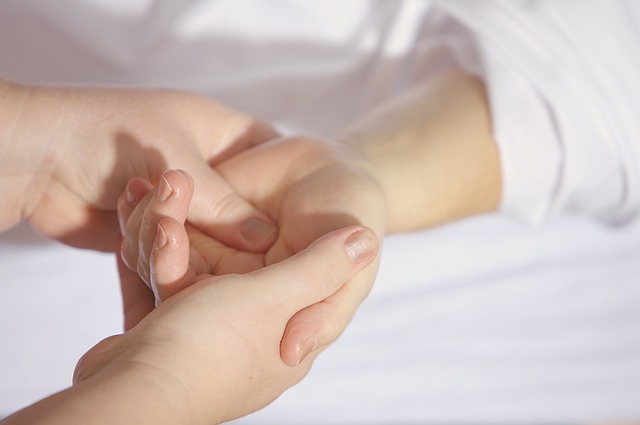Article Presentation
Effects of Closed Kinetic Chain Exercise Versus Open Kinetic Chain Exercise in Patellofemoral Pain Syndrome
By Boris Adrian K and Madhu Mitha R
PATELLOFEMORAL JOINT:
It is a diarthrodial joint that consists of the posterior surface of the patella and the trochlear surface of the distal anterior femur. The posterior surface of the patella has a multiple facets. The patella facets are convex in nature to accommodate the concave surface of the femur with the lateral side wider to help maintain the patellar position and stability. The patellofemoral joint is dependent on the static and dynamic soft tissue structure. Static stabilization is provided by the patellar tendon, ligamentous structure and joint capsule. Dynamic stabilization is provided by quadriceps, pes anserine, biceps femoris. The articulating surface of the patella is filled with thick layer of articular cartilage which dissipate the reaction force by the forceful contraction of the quadriceps.
BIOMECHANICS:
The patella plays a critical role in the last 30 degrees of knee extension whereas between 90 and 120 degrees of knee extension, the torque produced by the patella is about 13%. Clinically, the Q-angle is commonly used to identify alignment of the quadriceps muscle pull. The Q-angle is the angle between the line of pull of the quadriceps (anterior superior iliac spine to mid-patella) and a line connecting the center of patella with tibial tuberosity. An increased Q-angle is thought to create excessive lateral forces on the patella through a bowstring effect.
KINEMATICS:
Movement of the patella during tibiofemoral motion is dependent upon the active contraction of the quadriceps, the extensibility of the connective tissue about the patella, and the geometry of the patella and trochlear groove. As a gliding joint, the patella has movement in multiple planes. These motions include superior/inferior glide, medial and lateral glide, medial and lateral tilt, and medial and lateral rotation. Superior glide is also termed patellar extension and this motion occurs during tibiofemoral extension when the quadriceps contract creating a superior pull on the patella. An inferior glide is patellar flexion and occurs in conjunction with tibiofemoral flexion. Lateral and medial glide occur as translations in the frontal plane that correspond with tibiofemoral motion.
PATELLOFEMORAL PAIN SYNDROME:
Patellofemoral pain syndrome is the most prevalent knee injuries and it is caused by the activities which exerts more pressure on the patellofemoral joint like jumping, squatting, climbing the stairs. Since there are wide variety of symptoms that mimic the patellofemoral pain syndrome, malalignment of the lower extremity, increased Q angle, muscle disequilibrium, and decrease in length of VMO. There are many intervention like conservative and surgical intervention. However, conservative management has been suggested as an effective intervention for the patellofemoral pain syndrome. Some of the non surgical management of patellofemoral pain syndrome are exercise therapy, taping, brace and foot orthosis. Exercise emphasized on Quadriceps muscle strengthening considered as an effective means to alleviate the pain and improve the joint function in the patellofemoral pain syndrome. Chain exercises activate different parts of the extremity that provides situations which result in pressure production, extremity fixation, and ultimately pressure transport to the end of extremity.
OPEN KINETIC CHAIN EXERCISES IN PATELLOFEMORAL PAIN SYNDROME:
Open kinetic chain exercise are the traditional mode of exercise used for strengthening of the Quadriceps, in which the distal segment is not fixed and there is no weight bearing. Strengthening Quadriceps muscle particularly VMO, the contraction of VMO muscle cause the correct tracking of the patella and in turn diminish the forces on the knees which would eliminate the pain and improve the joint function. To explain the mechanism of OKC exercise in PFPS is that, Open kinetic chain exercise emphasized solely on strengthening of Quadriceps muscle which in turn improves the joint function. In addition to this, open kinetic exercise improve the neuromuscular function and thus it reduces the pain and significant increase in joint function. Improving neuromuscular function and muscle strengthening can mend the activity of muscle activity and in turn diminish the forces on knee joint. It has been commonly accepted to minimize patellofemoral joint stress open chain exercises should occur from 90 to 30 of knee flexion.
CLOSED KINETIC CHAIN EXERCISE IN PATELLOFEMORAL PAIN SYNDROME:
Close kinetic chain exercise are multiple articular movements in which distal segment is fixed and occasionally it is weight bearing. Training close kinetic chain exercise for the patients with patellofemoral pain syndrome produced positive effects in reducing the pain and in the improvement of joint function as these exercises are mostly of functional activities. Agonistic contraction of Quadriceps and Hamstrings in the CKC exercises improve the knee joint function as well as the tibiofemoral joint. As decreased proprioception cause PFPS, thus CKC exercise increase the muscle spindle sensitivity which in turn increase the afferent neuron information to the central nervous system about the position of the joint, improves the proprioception of the knee and improves the function of knee. When the foot is fixed, the PFJRF increases from 90 to 45 degrees, then decreases as the knee approaches full extension.
OUTCOME MEASURES:
- Pain – VAS
- Joint function - Kujala score(AKPS)




